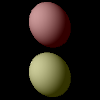Py5Shape.set_ambient()#
Sets a Py5Shape object’s ambient reflectance.
Examples#

def setup():
py5.size(100, 100, py5.P3D)
py5.background(0)
py5.directional_light(153, 153, 153, .5, 0, -1)
py5.ambient_light(50, 50, 50)
py5.no_stroke()
s = py5.create_shape(py5.SPHERE, 20)
s.set_ambient("#FF0000")
py5.shape(s, 50, 25)
s.set_ambient("#FFFF00")
py5.shape(s, 50, 75)
Description#
Sets a Py5Shape object’s ambient reflectance. This is combined with the ambient light component of the environment. The color components set through the parameters define the reflectance. For example in the default color mode, calling set_ambient(255, 127, 0), would cause all the red light to reflect and half of the green light to reflect. Use in combination with Py5Shape.set_emissive(), Py5Shape.set_specular(), and Py5Shape.set_shininess() to set the material properties of a Py5Shape object.
The ambient parameter can be applied to the entire Py5Shape object or to a single vertex.
This method can only be used for a complete Py5Shape object, and never within a Py5Shape.begin_shape() and Py5Shape.end_shape() pair.
This method has additional color functionality that is not reflected in the method’s signatures. For example, you can pass the name of a color (e.g. “green”, “mediumpurple”, etc). Look at the online “All About Colors” Python Ecosystem Integration tutorial for more information.
Underlying Processing method: PShape.setAmbient
Signatures#
set_ambient(
ambient: int, # any color value
/,
) -> None
set_ambient(
index: int, # vertex index
ambient: int, # any color value
/,
) -> None
Updated on December 25, 2023 16:36:33pm UTC
